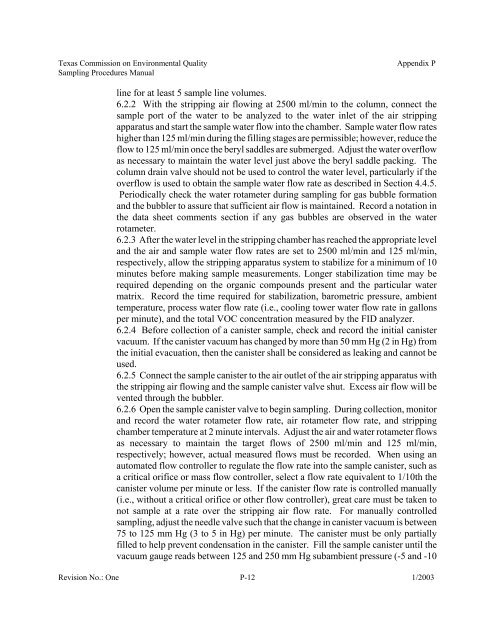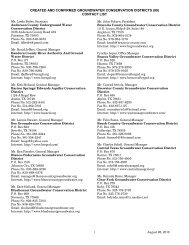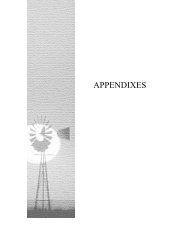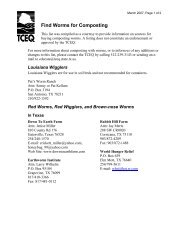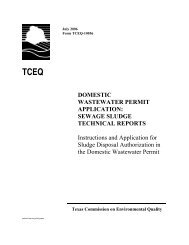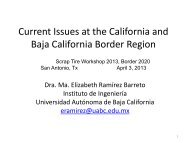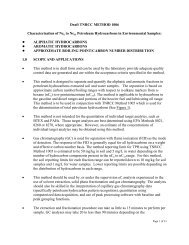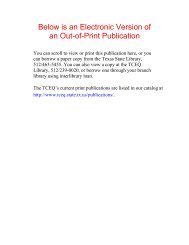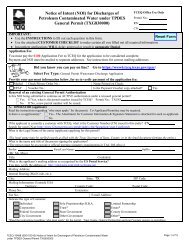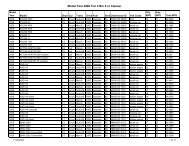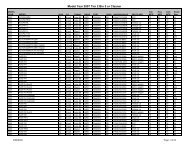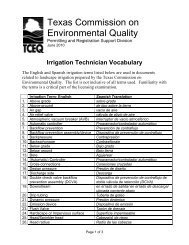APPENDIX P COOLING TOWER MONITORING General Cooling ...
APPENDIX P COOLING TOWER MONITORING General Cooling ...
APPENDIX P COOLING TOWER MONITORING General Cooling ...
Create successful ePaper yourself
Turn your PDF publications into a flip-book with our unique Google optimized e-Paper software.
Texas Commission on Environmental Quality Appendix PSampling Procedures Manualline for at least 5 sample line volumes.6.2.2 With the stripping air flowing at 2500 ml/min to the column, connect thesample port of the water to be analyzed to the water inlet of the air strippingapparatus and start the sample water flow into the chamber. Sample water flow rateshigher than 125 ml/min during the filling stages are permissible; however, reduce theflow to 125 ml/min once the beryl saddles are submerged. Adjust the water overflowas necessary to maintain the water level just above the beryl saddle packing. Thecolumn drain valve should not be used to control the water level, particularly if theoverflow is used to obtain the sample water flow rate as described in Section 4.4.5.Periodically check the water rotameter during sampling for gas bubble formationand the bubbler to assure that sufficient air flow is maintained. Record a notation inthe data sheet comments section if any gas bubbles are observed in the waterrotameter.6.2.3 After the water level in the stripping chamber has reached the appropriate leveland the air and sample water flow rates are set to 2500 ml/min and 125 ml/min,respectively, allow the stripping apparatus system to stabilize for a minimum of 10minutes before making sample measurements. Longer stabilization time may berequired depending on the organic compounds present and the particular watermatrix. Record the time required for stabilization, barometric pressure, ambienttemperature, process water flow rate (i.e., cooling tower water flow rate in gallonsper minute), and the total VOC concentration measured by the FID analyzer.6.2.4 Before collection of a canister sample, check and record the initial canistervacuum. If the canister vacuum has changed by more than 50 mm Hg (2 in Hg) fromthe initial evacuation, then the canister shall be considered as leaking and cannot beused.6.2.5 Connect the sample canister to the air outlet of the air stripping apparatus withthe stripping air flowing and the sample canister valve shut. Excess air flow will bevented through the bubbler.6.2.6 Open the sample canister valve to begin sampling. During collection, monitorand record the water rotameter flow rate, air rotameter flow rate, and strippingchamber temperature at 2 minute intervals. Adjust the air and water rotameter flowsas necessary to maintain the target flows of 2500 ml/min and 125 ml/min,respectively; however, actual measured flows must be recorded. When using anautomated flow controller to regulate the flow rate into the sample canister, such asa critical orifice or mass flow controller, select a flow rate equivalent to 1/10th thecanister volume per minute or less. If the canister flow rate is controlled manually(i.e., without a critical orifice or other flow controller), great care must be taken tonot sample at a rate over the stripping air flow rate. For manually controlledsampling, adjust the needle valve such that the change in canister vacuum is between75 to 125 mm Hg (3 to 5 in Hg) per minute. The canister must be only partiallyfilled to help prevent condensation in the canister. Fill the sample canister until thevacuum gauge reads between 125 and 250 mm Hg subambient pressure (-5 and -10Revision No.: One P-121/2003


